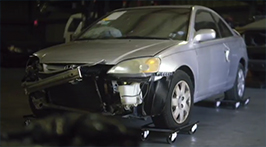Grinders are used to cut, smooth, refine, or polish the surface of a given material. Grinders serve a number of commercial, industrial, and household uses, and are most commonly used by metal workers. There are two main types of grinders: the handheld angle grinder and the stationary grinding machine.
Handheld angle grinders are typically used for more detailed grinding operations, such as sanding, paint stripping, and polishing. They are powered by internal motors, compressed air, or a gas engine. The main parts include an abrasive disc, which is replaceable, the motor that drives the disc, the safety guard, and the handle.
Stationary grinding machines are available in a number of fixed types, but all machines feature a grinding disc covered with an abrasive surface, a bed for guiding the material, a motor, and safety guards.
Grinder Defects and Failure
Grinders of both types suffer failure due to overheating and damage to the grinding wheels. Poorly constructed grinding wheels have also been known to shred during the grinding process, requiring safety protection from flying particles. Wheels may also latch into the material to be ground, causing injuries as the tool and item are jerked from the force behind the spinning wheel. Overheating is another leading defect in grinders. This is more common for heavy gauge grinding work on grinding machines and on work with angle grinders. Overheated grinders can cause additional kickback and are more likely to have disc failure.
Grinder discs that break or shatter make grinders (especially angle grinders) some of the most dangerous tools in the metal working industry. The particles from the shattered discs are the leading cause of injuries related to grinding work.
Injuries from Grinders
Injuries related to grinder product failures impact the hands, arms, face, and eyes of operators. The most commonly reported injuries are related to disc failure, where particles from a broken disc become lodged in an operator’s eye.
Additional injuries are caused to hands, arms, and faces of operators of both angle grinders and grinding machines when discs malfunction. These injuries consist primarily of lacerations from inadvertent contact with the wheel and puncture wounds from flying disc particles.
Defective Grinders
Bosch GWS Angle Grinder
The Bosch GWS 8-115 angle grinder is known to overheat, especially during longer grinding sessions.
Makita Angle Grinder
On November 10, 2005, Makita U.S.A. recalled approximately 1,500 Makita 7-inch angle grinders. The recalled products had a possible projectile risk, as the safety guards do not cover the grinding wheel properly. The grinders were sold through industrial suppliers and home centers from July 2005 through September 2005 with model number GA7011C.
Sources
- Shamir. (2009, May). Forum Post. Retrieved January 17 2010 fromhttp://www.instructables.com/answers/My-angle-grinder-gets-very-hot-How-…
- Queensland Government Department of Employment and Industrial Relations. (2009, January). “Metal Product Manufacturing Industry – Angle Grinders”. Workplace Health And Safety.
